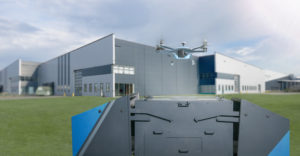
Autonomous drones have become a critical tool for business continuity in a wide variety of enterprise verticals. As the current crisis changes the way companies work, new tools are part of the new normal. Read on for an insider view of how industries like power and gas or critical infrastructure are continuing to function despite current limitations.
The following is a DRONELIFE exclusive guest post by Illy Gruber, business expert and V.P. of Marketing at Percepto, makers of “drone in a box” solutions to enable autonomous drone missions. DRONELIFE neither accepts nor makes payment for guest posts.
Why Autonomous Drones are Now Crucial to Business Continuity
For companies that remain active and those that have temporarily shut down in light of the Coronavirus crisis, autonomous technology is playing a significant and growing role in maintaining business continuity.
Business continuity refers to how organizations can maintain or resume business functions quickly in the face of major disruptions – like, you guessed it, a pandemic. These plans, which companies spend years developing and tweaking, generally contain specific procedures and instructions that organizations need to follow as regards to infrastructure, maintenance, security, business partners, human resources, and more.
Until now, most organizations had created business continuity plans – and shelved them. Now, all of a sudden, we’re seeing the majority of SMEs, SMBs and enterprises actually implement such plans. The theory looks much different in practice, and I’m sure that companies will yet be significantly revising their plans when life returns to whatever the new normal looks like.
At Percepto, we’re seeing more and more of our customers and prospective customers turning to autonomous drones and other remote autonomous and robotic solutions to ensure business continuity. In fact, some of our customers have actually defined their autonomous drone systems as critical assets that must be kept operational under their business continuity plans.
Here’s how we’re seeing companies use autonomous drones to facilitate business continuity in the face of the Coronavirus crisis.
Security
We have a number of large industrial clients that have been forced to suspend operations owing to the pandemic. Yet at the same time, these companies own large facilities containing valuable assets that need to be actively secured – operational or not.
These companies are using autonomous drones to maintain the same high level of facility security as previously, with far less manpower. This is important not only from a worker safety point of view, but also (regrettably) owing to the massive layoffs many companies are experiencing.
Elsewhere, a large wholesale chain is using our drone technology to more tightly secure stockpiled inventory in the face of surging demand, and amid concerns about civil unrest.
Maintenance
Large industrial and critical infrastructure facilities require massive ongoing maintenance. Whether this maintenance is intended to keep facilities operational (in the case of critical infrastructure) or ensure that they can quickly spin back up after the crisis (in the case of non-essential industry) – ongoing maintenance remains mission-critical.
By way of example, some of the world’s largest mining concerns halted production last week – notably Peru and Chile’s copper mines, which account together for some 12% of global copper production. These companies have a highly distributed and massive geographic presence, with multiple remote sites packed with complex refining infrastructure that needs ongoing monitoring and at least a minimal level of maintenance. Even in normal times, effective preventative maintenance is a challenge. And when manpower is nearly non-existent owing to governmental restrictions?
We’re seeing the same trend in critical infrastructure – water, power, ports, oil & gas, and numerous other sectors. Workers are unable to get to work owing to travel restrictions or illness – yet electricity, water, goods and oil need to keep flowing, especially with large portions of the population stuck at home. Our autonomous drones are facilitating ongoing maintenance and operations for such large scale, critical infrastructure sites.
The Bottom Line
Business continuity is not just a matter of profit these days. In many sectors – both critical infrastructure and commercial – it’s a matter of life and death. We’re seeing an uptick in usage of autonomous drones, both in volume and variety of missions, to facilitate business continuity. And as this wave of COVID-19 subsides, and companies prepare for a possible second wave or future, similar crisis – autonomous drones will be part of more and more contingency plans.
 With over 20 years of high-tech industry experience in companies like Qognify, NICE Systems, TTI Telecom and BVR Solutions, Illy is the V.P. of Marketing at Percepto. She specializes in building B2B marketing and go-to-market strategies targeting large enterprises, and has vast experience in video surveillance, video and data analytics and command and control solutions. Illy holds an MBA from the Kellogg School of Management at Northwestern University and a B.Sc. in Computer Science from the Academic College of Tel-Aviv-Jaffa.
With over 20 years of high-tech industry experience in companies like Qognify, NICE Systems, TTI Telecom and BVR Solutions, Illy is the V.P. of Marketing at Percepto. She specializes in building B2B marketing and go-to-market strategies targeting large enterprises, and has vast experience in video surveillance, video and data analytics and command and control solutions. Illy holds an MBA from the Kellogg School of Management at Northwestern University and a B.Sc. in Computer Science from the Academic College of Tel-Aviv-Jaffa.

Miriam McNabb is the Editor-in-Chief of DRONELIFE and CEO of JobForDrones, a professional drone services marketplace, and a fascinated observer of the emerging drone industry and the regulatory environment for drones. Miriam has penned over 3,000 articles focused on the commercial drone space and is an international speaker and recognized figure in the industry. Miriam has a degree from the University of Chicago and over 20 years of experience in high tech sales and marketing for new technologies.
For drone industry consulting or writing, Email Miriam.
TWITTER:@spaldingbarker
Subscribe to DroneLife here.







[…] drones – those that can be programmed to execute missions from a distance – are a growing market segment. While U.S. regulations for flight beyond visual line of sight […]